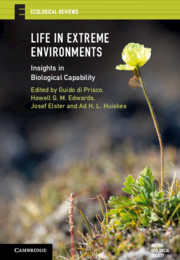Book contents
- Life in Extreme Environments
- Ecological Reviews
- Life in Extreme Environments
- Copyright page
- Dedication
- Contents
- Contributors
- Introduction
- Part I Extreme environments: responses and adaptation to change
- Part II Biodiversity, bioenergetic processes, and biotic and abiotic interactions
- Part III Life in extreme environments and the responses to change: the example of polar environments
- Part IV Life and habitability
- Chapter Thirteen Analytical astrobiology: the search for life signatures and the remote detection of biomarkers through their Raman spectral interrogation
- Chapter Fourteen Adaptation/acclimatisation mechanisms of oxyphototrophic microorganisms and their relevance to astrobiology
- Chapter Fifteen Life at the extremes
- Index
- Plate Section (PDF Only)
- References
Chapter Thirteen - Analytical astrobiology: the search for life signatures and the remote detection of biomarkers through their Raman spectral interrogation
from Part IV - Life and habitability
Published online by Cambridge University Press: 28 September 2020
- Life in Extreme Environments
- Ecological Reviews
- Life in Extreme Environments
- Copyright page
- Dedication
- Contents
- Contributors
- Introduction
- Part I Extreme environments: responses and adaptation to change
- Part II Biodiversity, bioenergetic processes, and biotic and abiotic interactions
- Part III Life in extreme environments and the responses to change: the example of polar environments
- Part IV Life and habitability
- Chapter Thirteen Analytical astrobiology: the search for life signatures and the remote detection of biomarkers through their Raman spectral interrogation
- Chapter Fourteen Adaptation/acclimatisation mechanisms of oxyphototrophic microorganisms and their relevance to astrobiology
- Chapter Fifteen Life at the extremes
- Index
- Plate Section (PDF Only)
- References
Summary
The application of Raman spectroscopic techniques to the characterisation of the protective biochemicals used in the survival strategies of extremophilic organisms in terrestrially stressed environments (Wynn-Williams and Edwards, 2000a, 2000b), coupled with the palaeogeological recognition that early Mars and Earth had maintained similar environments under which Archaean cyanobacteria could have developed (McKay,1997), has driven the proposal for the adoption of Raman spectroscopy as novel analytical instrumentation for planetary exploration
- Type
- Chapter
- Information
- Life in Extreme EnvironmentsInsights in Biological Capability, pp. 301 - 318Publisher: Cambridge University PressPrint publication year: 2020
References
- 1
- Cited by

